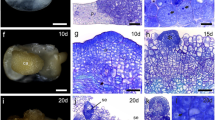Abstract.
Rearrangements of cortical microtubules (CMTs) during the differentiation of axial secondary xylem elements within taproots and shoots of Aesculus hippocastanum L. (horse-chestnut) are described. A correlative approach was employed using indirect immunofluorescence microscopy of α-tubulin in 6- to 10-μm sections and transmission electron microscopy of ultrathin sections. All cell types – fibres, vessel elements and axial parenchyma – derive from fusiform cambial cells which contain randomly oriented CMTs. At the early stages of development, fibres and axial parenchyma cells possess helically arranged CMTs, which increase in number as secondary wall thickening proceeds and simple pits develop. In contrast, incipient vessel elements are distinguished by the marking out of sites of bordered pits; these sites first appear as microtubule-free regions within the reticulum of randomly oriented CMTs that characterises their precursor fusiform cambial cells. Subsequently, the ring of CMTs which develops at the periphery of the microtubule-free region decreases in diameter as the over-arching pit border is formed. Like bordered pits, large-diameter, non-bordered pits (contact pits) which develop between vessel elements and adjacent contact ray cells originate as microtubule-free regions and are also associated with development of a ring of CMTs at the periphery. In the case of contact pits, however, there is no reduction in the diameter of the CMT ring during pit development. Tertiary cell wall thickenings are also a feature of vessel elements and appear to form at sites where bands of laterally associated, transversely oriented CMTs, separated from each other by microtubule-free zones, are found. Later, these bands of CMTs become narrower, and separate into pairs of microtubule bundles located on each side of the developing wall thickening. Development of perforations between vessel elements is also associated with the presence of a ring of CMTs at their periphery.
Similar content being viewed by others
Author information
Authors and Affiliations
Additional information
Received: 13 July 1998 / Accepted: 30 November 1998
Rights and permissions
About this article
Cite this article
Chaffey, N., Barnett, J. & Barlow, P. A cytoskeletal basis for wood formation in angiosperm trees: the involvement of cortical microtubules. Planta 208, 19–30 (1999). https://doi.org/10.1007/s004250050530
Issue Date:
DOI: https://doi.org/10.1007/s004250050530




